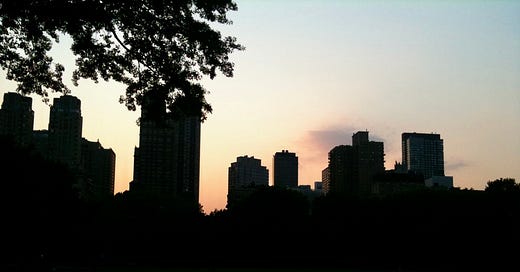Running is what the park is for
This is Western Coffee—notes on building the creative body. Last time: While there’s still time. The whole series is here.
Central Park was conceived in the 1840s, when the population of the enclosing city was about half a million. It was built, after a phase of boundary-settling and design-contesting and so on, over two decades stretching to 1876, the year that Alexander Graham Bell made his telephone call and Queen Victoria was legislated the Empress of India. It’s only the sixth-largest park in New York City, but its placement in the heart of Manhattan, and the formality with which it breaks from the cityscape that grew up around it, give it primacy among our public spaces. The Statue of Liberty, the Brooklyn Bridge, the Empire State Building: Those are icons. The park is a soul.
I pilgrimaged my way up Eighth Avenue to Central Park as soon as I moved here, after work one of the first evenings. It was July, which is the city’s sensory height—wet, hot, pungent, full of light. Those were my first fireflies, and as the road bikes raced past me in the gloaming I felt the rise on my skin that signals you’ve crossed into what Didion called the “shining and perishable dream.”
My experience of the city is that it has never broken its promise—not, especially not, in its pandemic depths; and not as my own life has, like the cells in my body, cycled into something mostly new. The city is at least as hospitable to the midlife triathlete scraping by in humanity’s strangest era while he pens a first novel as it was to the precocious fragile-boned editor imported from the Los Angeles Times—and consider that: You first think New York is where to be because it’s the desire of the world (or at least plays it on TV). Later you find out it’s the only place you could have made sense, and that this is true, if they stay, for the others. We’re here because the centrifuge of the universe flung us into this one little margin. New York is our atomic mass.
The linchpin of the promise is the park, which has eluded almost every tendency in its long and storied life to make it average, or worse—has remained always art. Surface-level road crossings, sports stadiums, underground parking garages: dustbin of history.
I didn’t really get to know it until I became a runner. Frederick Law Olmsted and Calvin Vaux were not, as far as I know, runners. But the landscape they designed—if I may stipulate contentiously—is for runners. Running is what the park is for.
I don’t know how to convince you of this if you don’t believe it already. It’s like interpreting a poem. But if you run, and then you run in Central Park, you feel it: the way the land was sculpted, not just to challenge and reward you but to hold your interest, to give you exactly what you need to make it just another mile, and then just one more. When you run fast, the road is vaulting and steel-springed; when you run slow, it lolls and cradles. When you run in winter, you understand the way that the whole land lies on the earth. When you run in summer, the dream is a uniform green and the city shows its angled grays only at high promontories, a lead weight against the sky. When you run in silence, there is no silence, but leaves rustling and kids laughing and rollers blading across the pavement. When you run in the presence of great music, it turns out to have been written—like the park was built—for the occasion.
Last weekend I crossed into this paradise in several little stripes of misery: at the end of a long training week, deflecting a vague need for a restroom with the potential to escalate, plenty of aches and pains. Lots of me didn’t want to be there, and I did the math on how far off my training curve I would fall if I dropped out. The result felt unacceptable, so I plodded forward, each cycle of consciousness unpleasant and vaguely embarrassing. It was too late in the morning, the track too sparse, and my pace too slow for the fail-safe option—run behind someone hot. So I dialed up Mahler 6 to max volume and snarfed some Swedish Fish. I said a more polite hello to my surroundings. And I joined the loop, where thousands upon thousands of other people had been in roughly the same boat, and mostly survived.
Please share this email. Sign up free or, if you’ve done that and enjoy the newsletter, sign up for a paid subscription to support my work. Kindly send me your thoughts, questions, and provocations: dmichaelowen@gmail.com.



